|
The Horridus Patch is done!
The Horridus Patch is a 12’ x 36’ 1/100 acre plot of ground at the midpoint of our sloped property. In 2007 we acquired 80 each Encephalartos horridus in 5 gallon containers that were about 5 years old. We knew that the blue cycads in containers grew very slowly yet were most in demand—customers would visit our nursery and their first question was “Where are the blues?” So, it was important that we grow these cycads quickly. Knowing that cycads in-the-ground grow 3 to 5 times faster than if grown in a container, and perhaps more important is that the cycad becomes acclimated and bonds with earth soil, we decided to plant out these 80 cycads in this plot of ground, where they would be exposed to the full arc of Escondido sun.
What was done and learned:
- 3 rows of horridus the length of 36’ were separated by 5’, thus 25 horridus were in each row with about 5 horridus left over to be placed on the left and right edges. What was learned: I would select a plot 4 times this amount if I were to do this again.
- Because these 5 gallon plants were already of size, it was not possible to roll out ground cloth, cut out a circle, and dig a hole and plant. Sticks from the horridus made it painfully difficult. Were there a lot of weeds without ground cloth? No, amazingly these rows grew together because the horridus is a cycad that profusely pups (grows offsets). Thus less light got through, and few weeds grew. One thing for sure, it wasn’t easy to be within this patch, only to be on the outside edges. Said another way, all hand-dug horridus had to be approached from the outside to the inside of this patch.
- Container-grown horridus grow carrot roots which are easily broken and allow input of harmful pathogens; fungicide must be used to minimize infection of the plant.
Horridus grown in hard DG (decomposed granite) grow string roots. Few, if any, carrot roots are grown. There are literally hundreds of string roots, perhaps a thousand for a 36” fused caudex size horridus that is 10 years old, or older. What does this mean? String roots don’t break easily, they bend. Even if a number are broken or cut, there are hundreds of perfectly formed string roots that will “carry the load” of bringing this horridus cycad to full health after digging. =>We have never experienced a 15 gallon or larger horridus dying or the caudex becoming “soft” after a digging operation. Apparently it is the nature of this (older) cycad to be robust, to be able to tolerate digging and transplanting when grown in hard ground.
One-half inch poly drip tubing was anchored along each row, and connected to our irrigation system. At each plant location a 1/2 gallon drip irrigation emitter was placed. Irrigation was set for twice a week, for 2 hours each time. In the winter rains, the irrigation was turned off.
OK, these 5 year-old cycads began to grow in the ground starting October, 2007. That means these cycads have been growing for 18 years!
Encephalartos horridus give an indication of what they will be like when mature but the true form and bright color of the leaves occurs only at maturity. You must see our large horridus to appreciate their beauty.
Here is a photo of the 80 cycads in this Horridus Patch on May 8, 2014, about 7 years of growth in the ground, starting from a 5 year-old horridus; they are about 30” tall. Six years later the spaces between these rows were closed, having no weeds, due to outstretched growth of horridus leaves and the addition of offsets around the parent caudexes. The cycads had grown to nearly 5’. The entire plot was densely covered and impenetrable.
Encephalartos horridus, 80 each, May 8, 2014
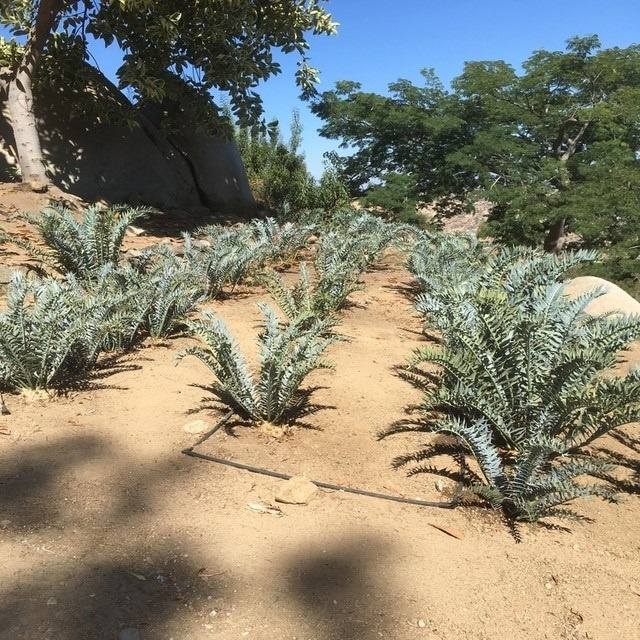
A Kubota tractor loader was used to slice 16” below the soil surface, then lift the cycad and place it on the ground near the potting area shown in the photo below. This avoids the arduous task of hand-digging each cycad with a shovel. In this unusual case the soil was dry and fell away from the root base upon lifting. With the cycad placed onto a workbench, all foreign roots, like those from the nearby Ficus robusta and Enterolobium tree, were removed. An inspection was done for damage to any carrot roots or string roots. If so, the exposed root surfaces were painted with a fungicide slurry. The cycad was then placed into a 15 gallon or 20 gallon container of our soil mix with lava rock, and lightly watered in.
Potting operation, November 1, 2020
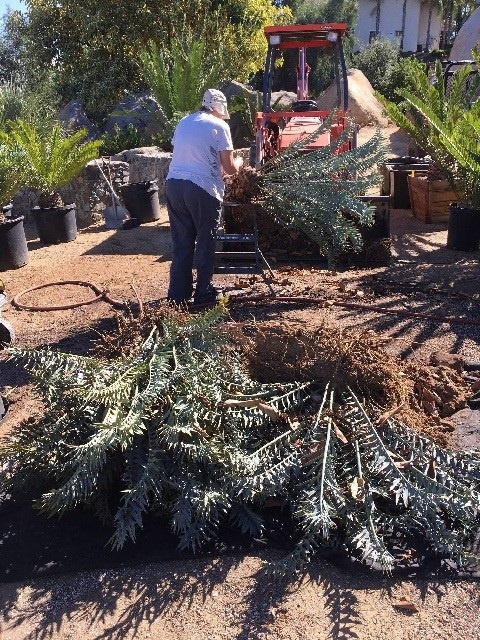
Here is the second dig of horridus with the Kubota tractor. It was necessary to go into hard soil that was difficult to slice, thus some roots were cut. It was decided to place these horridus in 3/8" pumice until March 2021. Regardless, they are healthy.
20 gallons in pumice
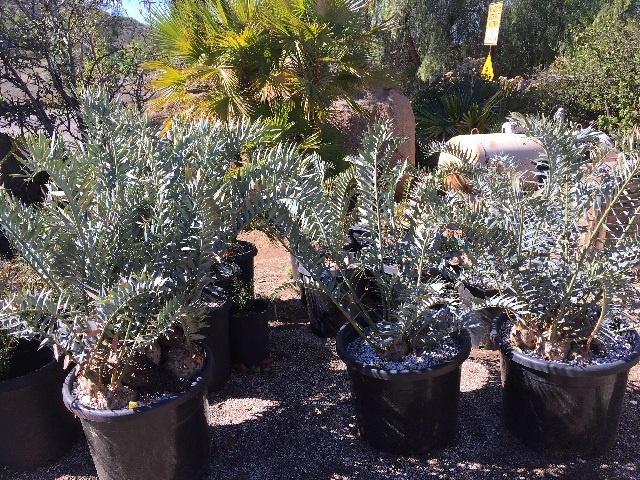
These horridus were dug by a operator using a Bobcat. This 16" slice below the root base of the hard soil was done without any roots cut so these horridus were potted into mixed soil.
15 gallons in mixed soil
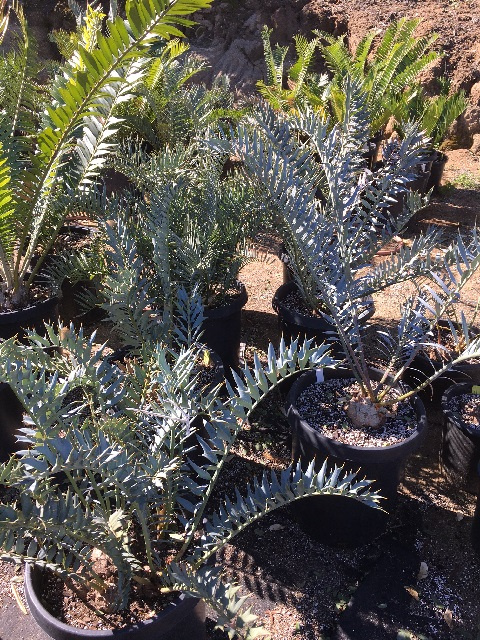
20 gallons in mixed soil
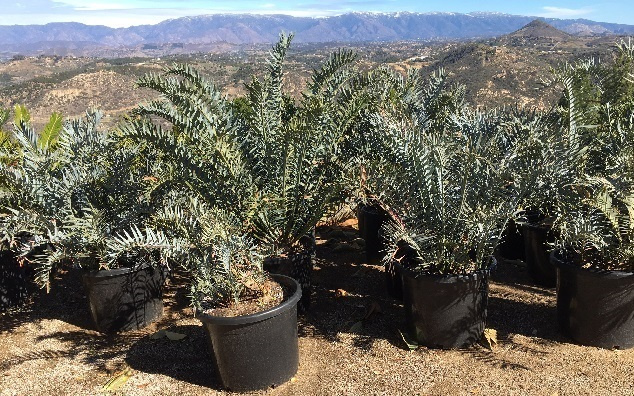
These are thunderous Encephalartos horridus cycads!
24" boxes in mixed soil
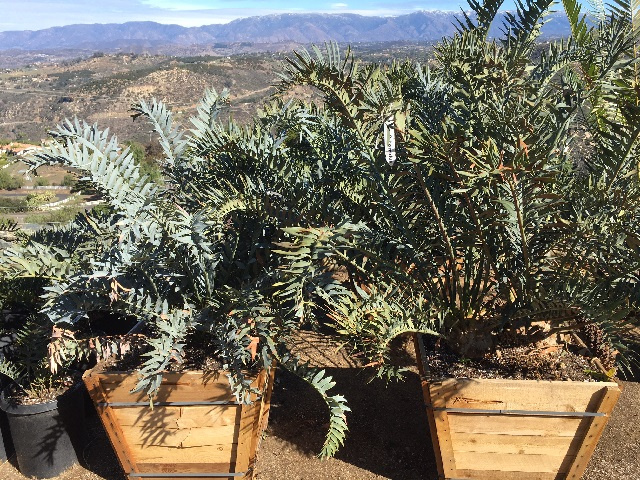
Newly available E. horridus cycads,
|
Encephalartos horridus
|
|
$120./inch
|
|
Pool Area
|
|
|
|
5 gal, 2.5"
|
1
|
|
|
5 gal, 3"
|
1
|
|
|
7 gal, 2.5" + 2 pups
|
1
|
|
|
7 gal, 4"
|
1
|
|
|
7 gal, 5" + 1 pup
|
1
|
|
|
7 gal, 7"
|
1
|
|
|
7 gal, "3", 2", 2", 2", 1.5", 1.5" (12")
|
1
|
|
|
15 gal, 3" SOLD!
|
0
|
|
|
15 gal, 4" + 1 pup, silver-blue, outstanding
|
1
|
|
|
15 gal, 6"
|
1
|
|
|
15 gal, 6"
|
1
|
|
|
15 gal, 6"
|
1
|
|
|
15 gal, 7"
|
1
|
|
|
15 gal, 7"
|
1
|
|
|
15 gal, 7.5"
|
1
|
|
|
15 gal, 7"+ 3 pups
|
1
|
|
|
15 gal, 5.5", 3.5", 3" + 1p (12")
|
1
|
|
|
15 gal, 5", 4", 4", 3.5, 3" (19.5")
|
1
|
|
|
20 gal, 5.5", 4", 4", 3", 2", 2" (20.5")
|
1
|
|
|
20 gal, 6" + 1 pup
|
1
|
|
|
20 gal, 11", beach ball form, incredible new flush! SOLD!
|
0
|
|
|
20 gal, 9", 2" (11")
|
1
|
|
|
20 gal, 8", 5" (13")
|
1
|
|
|
20 gal, 8.5", 8.5" (17")
|
1
|
|
|
20 gal, 6.5", 5", 3", 3", 2" (19.5")
|
1
|
|
|
20 gal, 8", 4.5", 4.5", 2.5" (19.5")
|
1
|
|
|
20 gal, 6", 6", 6", 5" (23")
|
1
|
|
|
20 gal, 7", 6", 6", 4" (23")
|
1
|
|
|
20 gal, 6", 4", 4", 3.5", 3", 3" (23.5")
|
1
|
|
|
20 gal, 7.5", 4", 4", 4", 3", 2" (24.5")
|
1
|
|
|
20 gal, 8", 6.5", 5", 4", 3.5" (27")
|
1
|
|
|
20 gal, 8", 6", 5", 4", 4", 3" +1 pup (30") perfect form!
|
1
|
|
|
30 gal, 11", 8", 7" + 3 pups (26")
|
1
|
|
|
24" box, 11", 9" (20")
|
1
|
|
|
24" box, 7", 5", 4", 4", 3", 3", 3", 2" (31")
|
1
|
|
|
24" box, 11", 8", 5", 4", 4", 4", 1p (36")
|
1
|
|
|
Driveway near Canary Palm
|
|
|
|
15 gal, 7"
|
1
|
|
|
15 gal, 7"
|
1
|
|
|
East of House
|
|
|
|
15 gal, 6"
|
1
|
|
|
West of Garage
|
|
|
|
15 gal, 4.5"
|
1
|
|
|
15 gal, 4", 2.5" (6.5")
|
1
|
|
|
15 gal, 6", 3" (9")
|
1
|
|
|
15 gal, 3.5", 3", 3", 2" (11.5")
|
1
|
|
|
15 gal, 5", 2", 2", 1.5", 1.5" (12")
|
1
|
|
|
15 gal, 4.5", 3.5", 2.5", 2", 2" (14.5")
|
1
|
|
|
24" box, 7", 6", 5", 5", 5", 5", 4" (37")
|
1
|
|
|
24" box, 9", 8", 7.5", 7", 6.5", 6", 5", 5", 4" (58")
|
1
|
|
|
Hobby House
|
|
|
|
5 gal, 3.5", rooting out
|
1
|
|
|
15 gal, 6"
|
1
|
|
|
North of Large Shadehouse
|
|
|
|
5 gal, 1.25"
|
1
|
|
|
5 gal, 1.75" + 2 pups
|
1
|
|
|
5 gal, 2.5"
|
1
|
|
|
7 gal, 5"
|
2
|
|
|
7 gal, 6"
|
2
|
|
|
|
|
|